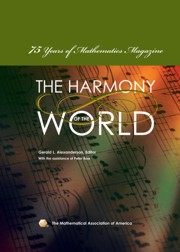Book contents
- Frontmatter
- Introduction
- Contents
- A Brief History of Mathematics Magazine
- Part I The First Fifteen Years
- Part II The 1940s
- The Generalized Weierstrass Approximation Theorem
- Hypatia of Alexandria
- Gauss and the Early Development of Algebraic Numbers
- Part III The 1950s
- Part IV The 1960s
- Part V The 1970s
- Part VI The 1980s
- Briefly Noted
- The Problem Section
- Index
- About the Editors
Hypatia of Alexandria
from Part II - The 1940s
- Frontmatter
- Introduction
- Contents
- A Brief History of Mathematics Magazine
- Part I The First Fifteen Years
- Part II The 1940s
- The Generalized Weierstrass Approximation Theorem
- Hypatia of Alexandria
- Gauss and the Early Development of Algebraic Numbers
- Part III The 1950s
- Part IV The 1960s
- Part V The 1970s
- Part VI The 1980s
- Briefly Noted
- The Problem Section
- Index
- About the Editors
Summary
Editors' Note: Today one can easily find a good deal of information about Hypatia, even a full-length biography, Hypatia of Alexandria, by Maria Dzielska (Harvard, 1995). Of course, little is known of her mathematical contributions even now since in most cases we have to rely on comments of others on works that are now lost. An attempt to tell what has come to light since the Richeson article is Michael A. B. Deakin's article “Hypatia and Her Mathematics” in the American Mathematical Monthly, 101 (1994), 234–243. Much recent work on Hypatia was done by the late Wilbur Knorr, a distinguished historian of mathematics at Stanford University. This work was not available to Richeson in 1940, of course. The article here is strikingly early in the literature in English devoted to Hypatia. So with this article Mathematics Magazine was publishing a groundbreaking work.
Richeson, a professor at the University of Maryland, received his PhD at Johns Hopkins under the direction of Frank Morley, best known for Morley's theorem in geometry, Morley was president of the American Mathematical Society, 1919–20. Richeson wrote on the history of mathematics and astronomy, and for the Magazine he contributed various articles including one on Laplace's work in pure mathematics.
The first woman mathematician regarding whom we have positive knowledge is the celebrated mathematician-philosopher Hypatia. The exact date of her birth is not known, but recent studies indicate that she was born about A. D. 370 in Alexandria.
- Type
- Chapter
- Information
- Harmony of the World75 Years of Mathematics Magazine, pp. 45 - 50Publisher: Mathematical Association of AmericaPrint publication year: 2007



